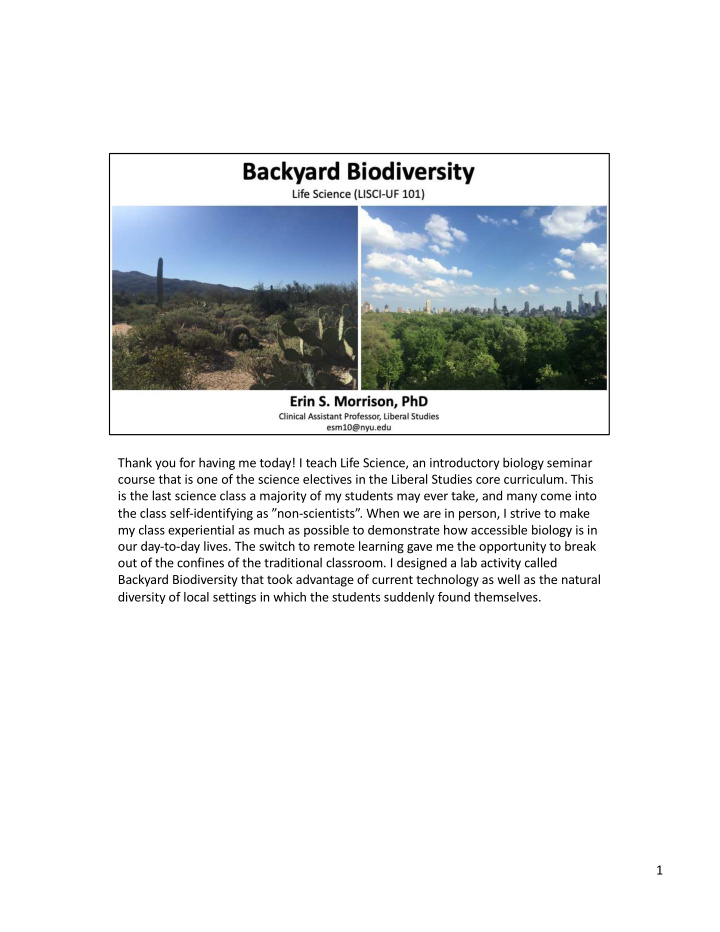



Thank you for having me today! I teach Life Science, an introductory biology seminar course that is one of the science electives in the Liberal Studies core curriculum. This is the last science class a majority of my students may ever take, and many come into the class self-identifying as ”non-scientists”. When we are in person, I strive to make my class experiential as much as possible to demonstrate how accessible biology is in our day-to-day lives. The switch to remote learning gave me the opportunity to break out of the confines of the traditional classroom. I designed a lab activity called Backyard Biodiversity that took advantage of current technology as well as the natural diversity of local settings in which the students suddenly found themselves. 1
In the lab activity, students were asked to compare the local plant diversity found in their current neighborhood to the plant species found by another student living in a different location. I designed the lab with four major objectives in mind. First, I wanted students to have the opportunity to step away from their computers and actually get outside to observe non-virtual biology. Second, the lab was a chance for students to make their own observations and collect these as data for future analyses. Third, once back inside the students needed to apply what they had learned about trait diversification, adaptation, evolution, and taxonomy to explain similarities and differences between the plant diversity observed in different places. Finally, each student needed to work with a partner to clearly summarize and present their results from their survey. Most importantly, I wanted the students to be able to achieve all of these objectives without needing to purchase any additional supplies. 2
In the first part of the lab, students were asked to take a 20-30 minute walk around their current neighborhood. During this walk, they were tasked with identifying and recording 20 unique plant species they observed. This was made possible by Seek, a free phone application that uses machine learning approaches to help identify species based on pictures. You can either hold the camera of a phone up to a plant or animal to get a real-time ID, or take pictures of a species and then later upload these pictures into the app for an ID once you are back on wifi. This app allowed 60 students with no prior knowledge of plants to identify a total of 1200 species. 3
Each student was then assigned 1-2 partners who were living in different locations and then, as a group, they were asked to make to make several comparisons between their neighborhoods. Throughout the rest of the presentation you will see slides that contain examples of students’ work on this project from the two groups shown here. The students first had to identify climate variables and level of development in each habitat so they could use these data to explain similarities and differences they observed in their plant lists. 4
Next, the students had to compare their species’ lists to determine the overlap, if any, between the species they identified in each location. As part of this comparison, I asked them to consider the adaptations observed in these plants to explain why some plants were more suited to one location than another or why some plants occurred in both locations. 5
To think further about the processes of adaptation and diversification, students were also asked to identify two examples of convergent and divergent evolution among the species in their lists based on observed traits and shared taxonomy. 6
Lastly, I asked each student to determine what proportion out of the species they identified were introduced into their location from somewhere else. I wanted them to think about why some locations had more introduced species than others, and what traits make introduced species so adaptable to new environments. Many groups made excellent points about how managed and aesthetically pleasing the plant species grown in urban and suburban areas are compared to wilderness areas. 7
Most of the work on the assignment was completed asynchronously, but at the end each group of students was asked to summarize their results in a 5 minute oral presentation during a synchronous zoom class. So much of remote learning is about the logistics of how and when students can access course material. This lab, in contrast, takes advantage of the fact that nature, in some form, is directly accessible from almost anywhere. I can easily see ways that this approach could be applied to other cultural and historical aspects of students’ current locations. It allows students to independently take control of their learning and apply it within their own communities. Remote learning infrastructure then provides them with the opportunity to talk about their local experiences in a global setting as they discuss their findings with other students located around the world. 8
Recommend
More recommend